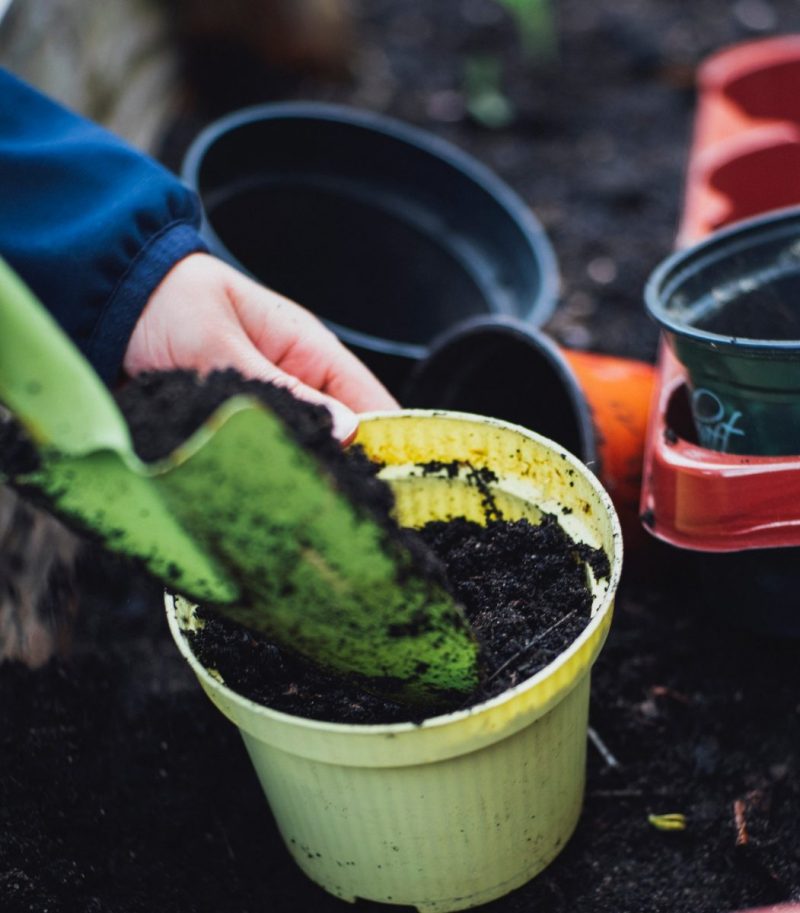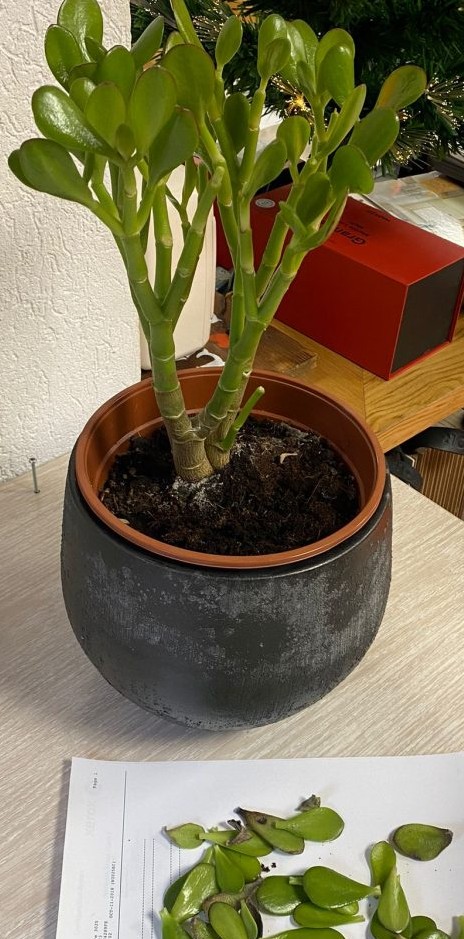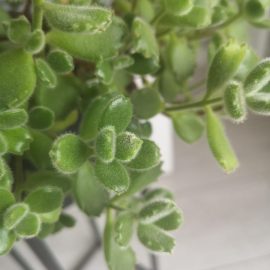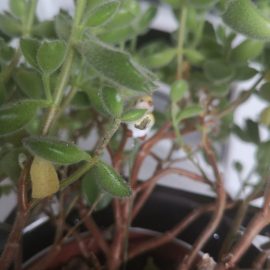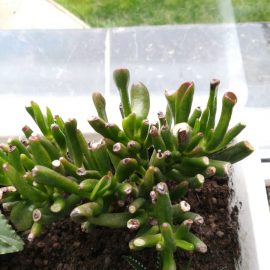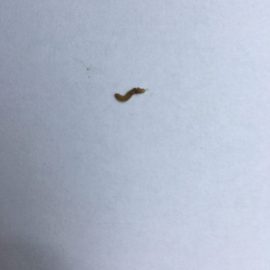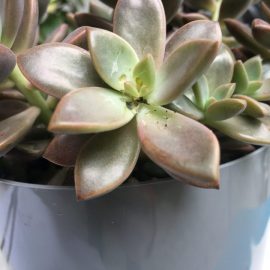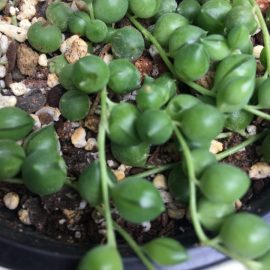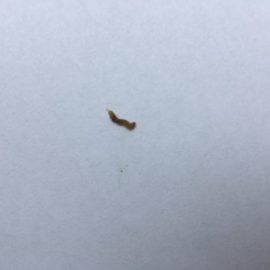Crassula ovata, plant care and growing guide
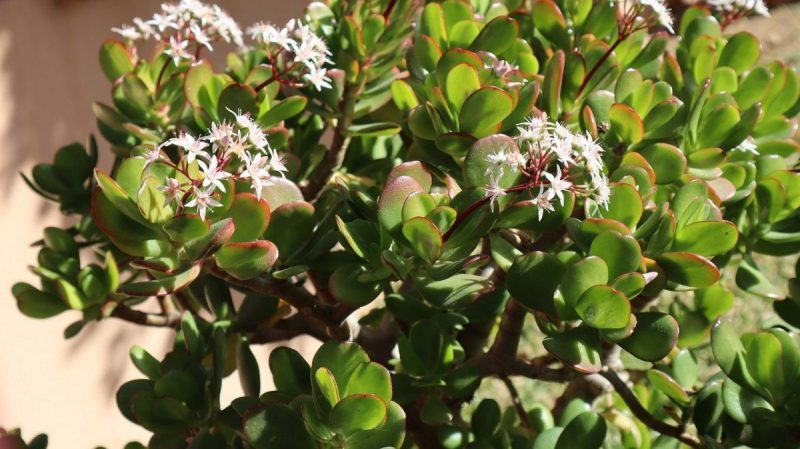
Crassula ovata, also popularly called jade plant, is a succulent plant that belongs to the Crassulaceae family, genus Crassula. It includes about 150 shrubby or subshrub species, dwarf or tall, native to the arid areas of South Africa and Asia. Crassula ovata has a compact growth, a cylindrical stem, well branched at the topside, and the leaves are obovate, succulent, bright green, oppositely arranged. It has white flowers that appear only on mature plants and usually bloom in the second half of summer and autumn.
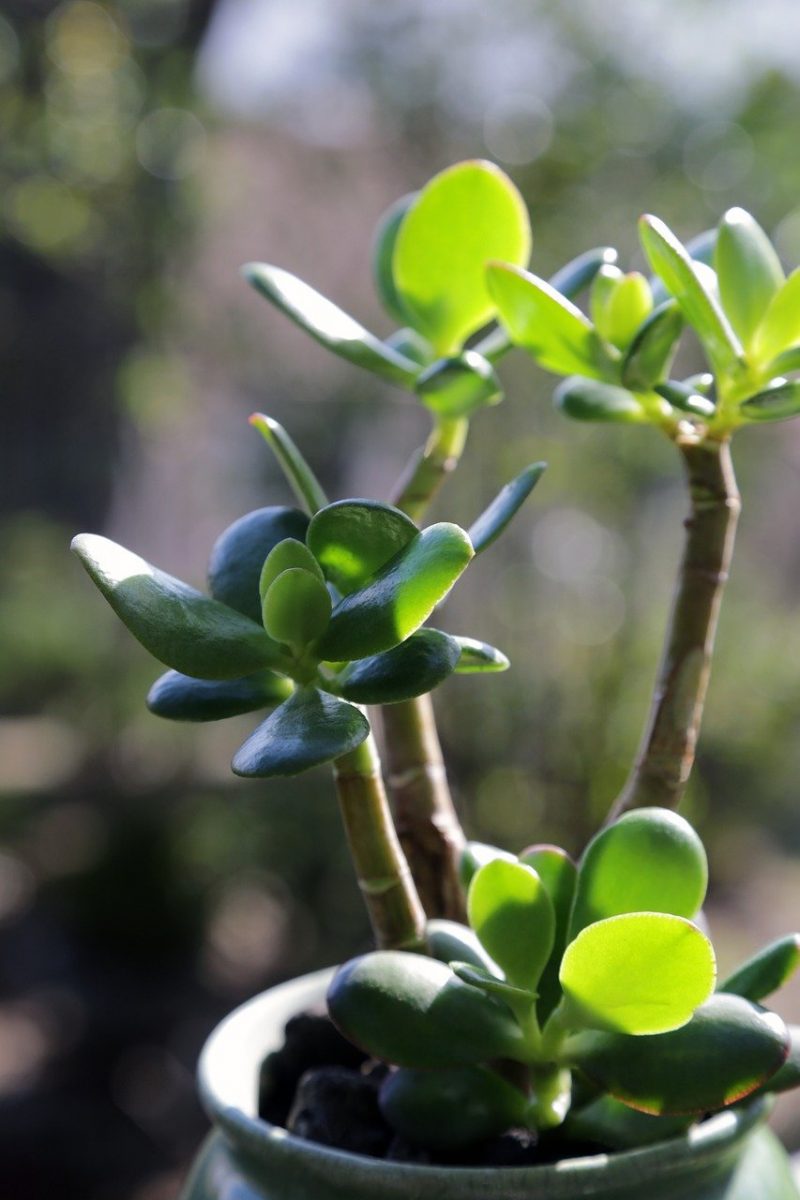
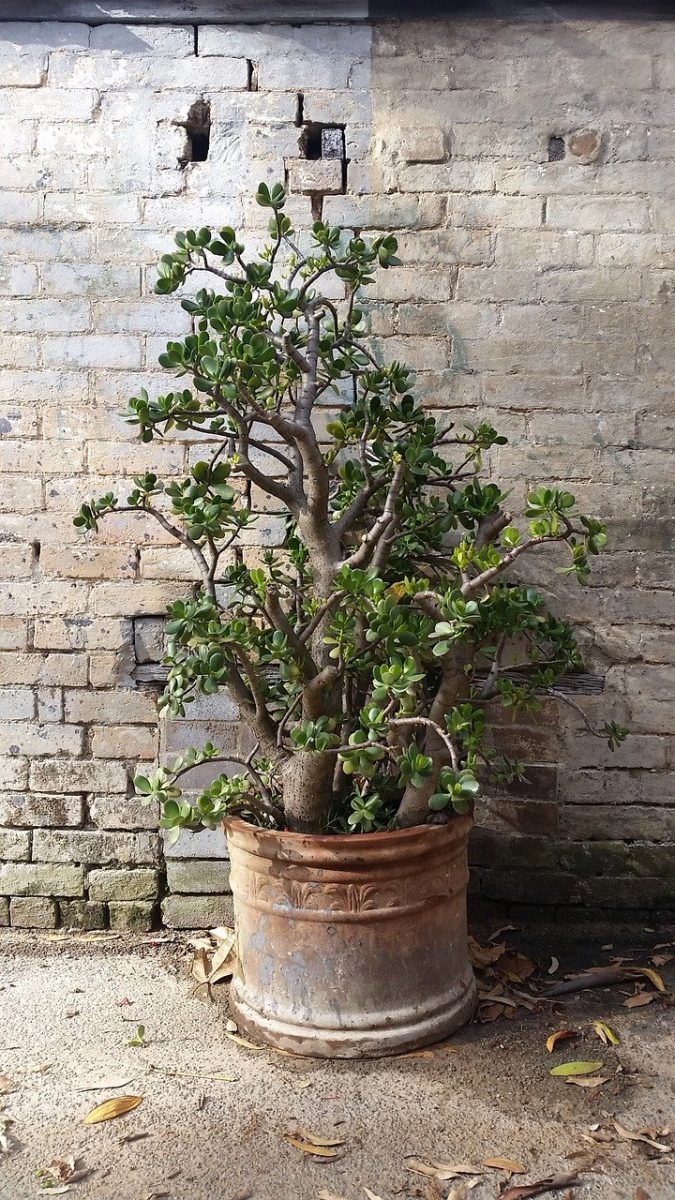
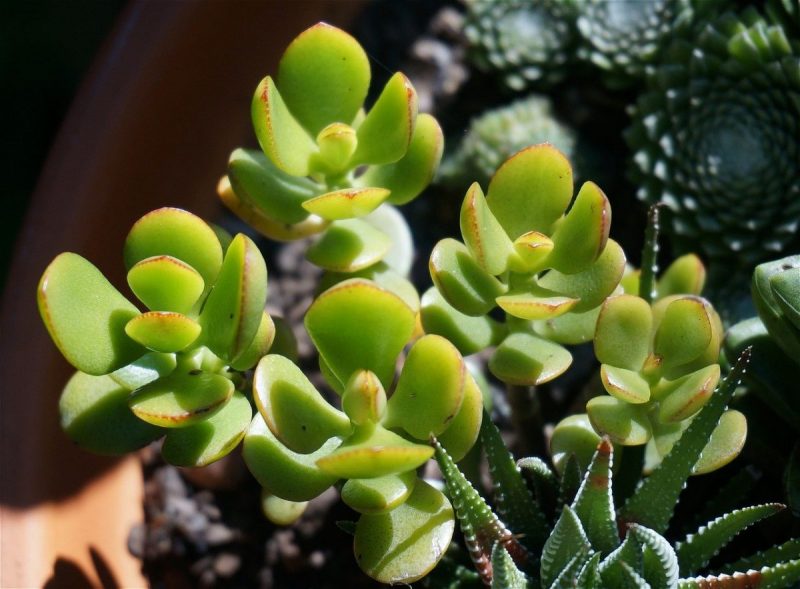
Environmental conditions
Light. It is a light-loving species, and for a harmonious growth and development, young specimens in particular need to be exposed to indirect light. However, both mature and young plants should benefit daily from at least 4-6 hours of indirect light.
Temperature. Crassula ovata prefers temperatures between 18-21 °C. In winter, the optimum temperature is 10-12 °C during the day and 7-9 °C at night. In summer, it can withstand temperatures of 29-30 °C.
Substrate. It is recommended to use a special substrate for succulent plants, which ensures the good drainage of water and thus prevents excessive moisture, persistent in the substrate, which can cause the occurrence of soil pathogens.
Recommended products
-
You can find products on a different store
Change Store -
You can find products on a different store
Change Store -
You can find products on a different store
Change Store -
You can find products on a different store
Change Store -
You can find products on a different store
Change Store -
You can find products on a different store
Change Store -
You can find products on a different store
Change Store -
You can find products on a different store
Change Store -
You can find products on a different store
Change Store -
You can find products on a different store
Change Store -
You can find products on a different store
Change Store -
You can find products on a different store
Change Store -
You can find products on a different store
Change Store -
You can find products on a different store
Change Store -
You can find products on a different store
Change Store -
You can find products on a different store
Change Store -
You can find products on a different store
Change Store -
You can find products on a different store
Change Store -
You can find products on a different store
Change Store -
You can find products on a different store
Change Store -
You can find products on a different store
Change Store -
You can find products on a different store
Change Store -
You can find products on a different store
Change Store -
You can find products on a different store
Change Store
Care
Watering. During the vegetative growth period (spring-summer) watering should be done moderately, allow the substrate to dry before watering again. Also, after each watering, the surplus that accumulates in the tray needs to be removed every time, because the stagnation of the water can lead to the suffocation of the roots and the occurrence of diseases.
Fertilization. During the vegetative growth period, it is recommended to administer fertilizers specially formulated for succulent plants.
Recommended products
-
You can find products on a different store
Change Store -
You can find products on a different store
Change Store -
You can find products on a different store
Change Store -
You can find products on a different store
Change Store -
You can find products on a different store
Change Store -
You can find products on a different store
Change Store -
You can find products on a different store
Change Store -
You can find products on a different store
Change Store -
You can find products on a different store
Change Store -
You can find products on a different store
Change Store -
You can find products on a different store
Change Store -
You can find products on a different store
Change Store -
You can find products on a different store
Change Store -
You can find products on a different store
Change Store -
You can find products on a different store
Change Store -
You can find products on a different store
Change Store -
You can find products on a different store
Change Store -
You can find products on a different store
Change Store -
You can find products on a different store
Change Store -
You can find products on a different store
Change Store -
You can find products on a different store
Change Store -
You can find products on a different store
Change Store -
You can find products on a different store
Change Store -
You can find products on a different store
Change Store
Propagation. It can be done by stem or leaf cuttings. The optimal propagation period is considered to be during the summer, when the plants naturally benefit from sufficient light and humidity.
Propagation by stem cuttings. It is done with cuttings harvested from mature, healthy plants. The seedlings are harvested when they are at least 5-7 cm long, then left to dry for a few days. Subsequently, after the respective part has dried, they will be planted in a substrate specially designed for this purpose.
Propagation by leaf cuttings. It is done with cuttings harvested from mature, healthy plants. The process consists in removing (with a slight twist) / cutting a leaf (with a small portion of the stem), which is then rooted (after the section has dried) in a substrate specially designed for this purpose.
Recommended products
-
You can find products on a different store
Change Store -
You can find products on a different store
Change Store -
You can find products on a different store
Change Store -
You can find products on a different store
Change Store -
You can find products on a different store
Change Store -
You can find products on a different store
Change Store -
You can find products on a different store
Change Store -
You can find products on a different store
Change Store -
You can find products on a different store
Change Store -
You can find products on a different store
Change Store -
You can find products on a different store
Change Store -
You can find products on a different store
Change Store -
You can find products on a different store
Change Store -
You can find products on a different store
Change Store -
You can find products on a different store
Change Store -
You can find products on a different store
Change Store -
You can find products on a different store
Change Store -
You can find products on a different store
Change Store -
You can find products on a different store
Change Store -
You can find products on a different store
Change Store -
You can find products on a different store
Change Store -
You can find products on a different store
Change Store -
You can find products on a different store
Change Store -
You can find products on a different store
Change Store
Transplanting. Normally, it can be done once every 2-3 years in the case of young plants and once every 4-5 years in the case of mature specimens.
Diseases and pests. Due to high humidity, persistent in the substrate, various soil pathogens can occur. The most common pests that can attack Crassula ovata are wooly apple aphids, but it can also be affected by European fruit lecanium or red spider mites. To control diseases and pests, it is recommended to carry out treatments with specific products, depending on the pathogen / pest targeted.
Recommended products
-
You can find products on a different store
Change Store -
You can find products on a different store
Change Store -
You can find products on a different store
Change Store -
You can find products on a different store
Change Store -
You can find products on a different store
Change Store -
You can find products on a different store
Change Store -
You can find products on a different store
Change Store -
You can find products on a different store
Change Store -
You can find products on a different store
Change Store -
You can find products on a different store
Change Store -
You can find products on a different store
Change Store -
You can find products on a different store
Change Store -
You can find products on a different store
Change Store -
You can find products on a different store
Change Store -
You can find products on a different store
Change Store -
You can find products on a different store
Change Store -
You can find products on a different store
Change Store -
You can find products on a different store
Change Store -
You can find products on a different store
Change Store -
You can find products on a different store
Change Store -
You can find products on a different store
Change Store -
You can find products on a different store
Change Store -
You can find products on a different store
Change Store -
You can find products on a different store
Change Store
Recommended products
-
You can find products on a different store
Change Store -
You can find products on a different store
Change Store -
You can find products on a different store
Change Store -
You can find products on a different store
Change Store -
You can find products on a different store
Change Store -
You can find products on a different store
Change Store -
You can find products on a different store
Change Store -
You can find products on a different store
Change Store -
You can find products on a different store
Change Store -
You can find products on a different store
Change Store -
You can find products on a different store
Change Store -
You can find products on a different store
Change Store -
You can find products on a different store
Change Store -
You can find products on a different store
Change Store -
You can find products on a different store
Change Store -
You can find products on a different store
Change Store -
You can find products on a different store
Change Store -
You can find products on a different store
Change Store -
You can find products on a different store
Change Store -
You can find products on a different store
Change Store -
You can find products on a different store
Change Store -
You can find products on a different store
Change Store -
You can find products on a different store
Change Store -
You can find products on a different store
Change Store
In order to detect in time the presence of pests (flies, aphids, etc.) and to be able to apply a treatment, from the initial phase of the attack, it is recommended to use traps.
Recommended products
-
You can find products on a different store
Change Store -
You can find products on a different store
Change Store -
You can find products on a different store
Change Store -
You can find products on a different store
Change Store -
You can find products on a different store
Change Store -
You can find products on a different store
Change Store -
You can find products on a different store
Change Store -
You can find products on a different store
Change Store -
You can find products on a different store
Change Store -
You can find products on a different store
Change Store -
You can find products on a different store
Change Store -
You can find products on a different store
Change Store -
You can find products on a different store
Change Store -
You can find products on a different store
Change Store -
You can find products on a different store
Change Store -
You can find products on a different store
Change Store -
You can find products on a different store
Change Store -
You can find products on a different store
Change Store -
You can find products on a different store
Change Store -
You can find products on a different store
Change Store -
You can find products on a different store
Change Store -
You can find products on a different store
Change Store -
You can find products on a different store
Change Store -
You can find products on a different store
Change Store
Additionally, in order to increase the plant’s resistance to the attack of phytopathogens and to keep pests away, it is recommended to administer specific fertilizers, according to the recommendations on the label.
Common problems that may occur
Leaf fall
If this phenomenon has a high frequency, it could occur due to the fact that the plant does not receive enough light. In this sense, it is recommended that the plant be placed in a brighter place, where it benefits from at least 6 hours of indirect light per day. At the same time, it is recommended to follow the evolution of the plant after taking this measure, in order to be able to observe if the phenomenon is accentuated or if it stops.
Additionally, if most of the falling leaves are old or if the loss of leaves is accompanied by an etiolated growth of the plant, the temperature in that room may be too high, therefore, it is recommended to move it to a room with slightly lower temperatures.
Recommended products
-
You can find products on a different store
Change Store -
You can find products on a different store
Change Store -
You can find products on a different store
Change Store -
You can find products on a different store
Change Store -
You can find products on a different store
Change Store -
You can find products on a different store
Change Store -
You can find products on a different store
Change Store -
You can find products on a different store
Change Store -
You can find products on a different store
Change Store -
You can find products on a different store
Change Store -
You can find products on a different store
Change Store -
You can find products on a different store
Change Store -
You can find products on a different store
Change Store -
You can find products on a different store
Change Store -
You can find products on a different store
Change Store -
You can find products on a different store
Change Store -
You can find products on a different store
Change Store -
You can find products on a different store
Change Store -
You can find products on a different store
Change Store -
You can find products on a different store
Change Store -
You can find products on a different store
Change Store -
You can find products on a different store
Change Store -
You can find products on a different store
Change Store -
You can find products on a different store
Change Store
Withering of the leaves
Crassula ovata is a succulent plant, and the main characteristic of succulents is to store water in thickened organs (leaves, stems, even roots). Thus, if the leaves or the whole plant has a withered appearance, it is often a sign that it is not receiving enough water, and after proper watering, the general state of the plant should improve.
The overall yellowing of the plant
It often occurs in case of excessive watering, therefore, it is recommended that watering be done moderately, leaving the substrate to dry before watering again, according to the requirements of the species.
The information on the various problems that may arise is indicative and can often be the result of a much greater accumulation of biotic and abiotic factors. Therefore, when the first symptoms appear, it is advisable to consult a specialist for a suitable recommendation.
Additionally:
- Direct sunlight can cause burns to young plants and reddening of the leaves, in the case of mature plants;
- It is a toxic plant for dogs and cats.

















































































































































































































































































































































































































































